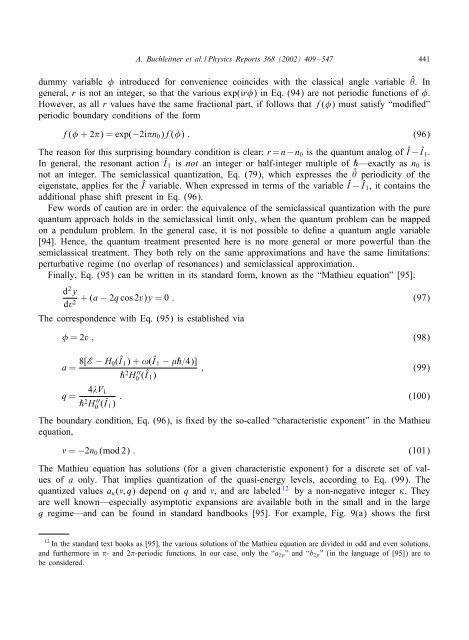Non-dispersive wave packets in periodically driven quantum systems
Non-dispersive wave packets in periodically driven quantum systems
Non-dispersive wave packets in periodically driven quantum systems
You also want an ePaper? Increase the reach of your titles
YUMPU automatically turns print PDFs into web optimized ePapers that Google loves.
A. Buchleitner et al. / Physics Reports 368 (2002) 409–547 441<br />
dummy variable <strong>in</strong>troduced for convenience co<strong>in</strong>cides with the classical angle variable ˆ . In<br />
general, r is not an <strong>in</strong>teger, so that the various exp(ir ) <strong>in</strong> Eq. (94) are not periodic functions of .<br />
However, as all r values have the same fractional part, if follows that f( ) must satisfy “modi ed”<br />
periodic boundary conditions of the form<br />
f( +2 ) = exp(−2i n0)f( ) : (96)<br />
The reason for this surpris<strong>in</strong>g boundary condition is clear: r =n−n0 is the <strong>quantum</strong> analog of Î −Î1.<br />
In general, the resonant action Î 1 is not an <strong>in</strong>teger or half-<strong>in</strong>teger multiple of ˝—exactly as n0 is<br />
not an <strong>in</strong>teger. The semiclassical quantization, Eq. (79), which expresses the ˆ periodicity of the<br />
eigenstate, applies for the Î variable. When expressed <strong>in</strong> terms of the variable Î − Î 1, it conta<strong>in</strong>s the<br />
additional phase shift present <strong>in</strong> Eq. (96).<br />
Few words of caution are <strong>in</strong> order: the equivalence of the semiclassical quantization with the pure<br />
<strong>quantum</strong> approach holds <strong>in</strong> the semiclassical limit only, when the <strong>quantum</strong> problem can be mapped<br />
on a pendulum problem. In the general case, it is not possible to de ne a <strong>quantum</strong> angle variable<br />
[94]. Hence, the <strong>quantum</strong> treatment presented here is no more general or more powerful than the<br />
semiclassical treatment. They both rely on the same approximations and have the same limitations:<br />
perturbative regime (no overlap of resonances) and semiclassical approximation.<br />
F<strong>in</strong>ally, Eq. (95) can be written <strong>in</strong> its standard form, known as the “Mathieu equation” [95]:<br />
d2y +(a− 2q cos 2v)y =0: (97)<br />
dv2 The correspondence with Eq. (95) is established via<br />
=2v; (98)<br />
a = 8[E − H0(Î 1)+!(Î 1 − ˝=4)]<br />
˝2H ′′<br />
0 (Î 1)<br />
4 V1<br />
q =<br />
˝2H ′′<br />
0 (Î 1)<br />
; (99)<br />
: (100)<br />
The boundary condition, Eq. (96), is xed by the so-called “characteristic exponent” <strong>in</strong> the Mathieu<br />
equation,<br />
= −2n0 (mod 2) : (101)<br />
The Mathieu equation has solutions (for a given characteristic exponent) for a discrete set of values<br />
of a only. That implies quantization of the quasi-energy levels, accord<strong>in</strong>g to Eq. (99). The<br />
quantized values a ( ; q) depend on q and , and are labeled 12 by a non-negative <strong>in</strong>teger . They<br />
are well known—especially asymptotic expansions are available both <strong>in</strong> the small and <strong>in</strong> the large<br />
q regime—and can be found <strong>in</strong> standard handbooks [95]. For example, Fig. 9(a) shows the rst<br />
12 In the standard text books as [95], the various solutions of the Mathieu equation are divided <strong>in</strong> odd and even solutions,<br />
and furthermore <strong>in</strong> - and 2 -periodic functions. In our case, only the “a2p” and “b2p” (<strong>in</strong> the language of [95]) are to<br />
be considered.











